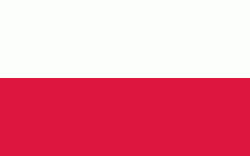Province of Posen (Poznań)
 |
 |
Posen (present-day Poznań, Poland) was the provincial capital.
The land is mostly flat, drained by two major watershed systems; the Noteć (German: Netze) in the north and the Warta (Warthe) in the center. Ice Age glaciers left moraine deposits and the land is speckled with hundreds of "finger lakes", streams flowing in and out on their way to one of the two rivers.
Agriculture was the primary industry. The three-field system was used to grow a variety of crops, primarily rye, sugar beet, potatoes, other grains, and some tobacco and hops. Significant parcels of wooded land provided building materials and firewood. Small numbers of livestock existed, including geese, but a fair number of sheep were herded.
The 29000 km2 area roughly corresponded to the historic region of Greater Poland. For more than a century, it was part of the Prussian Partition, with a brief exception during the Napoleonic Wars. When this area came under Prussian control, the feudal system was still in force. It was officially ended in Prussia (see Freiherr vom Stein) in 1810 (1864 in Congress Poland), but lingered in some practices until the late 19th century. The situation was thus that (primarily) Polish serfs lived and worked side by side with (predominantly) free German settlers. Though the settlers were given initial advantages, in time their lots were not much different. Serfs worked for the noble lord, who took care of them. Settlers worked for themselves and took care of themselves, but paid taxes to the lord.
Typically, an estate would have its manor and farm buildings, and a village nearby for the Polish laborers. Near that village, there might be a German settlement. And in the woods, there would be a forester's dwelling. The estate owners, usually of the nobility, owned the local grist mill, and often other types of mills or perhaps a distillery. In many places, windmills dotted the landscape, reminding one of the earliest settlers, the Dutch, who began the process of turning unproductive river marshes into fields. This process was finished by the German settlers employed to reclaim unproductive lands (not only marshland) for the host estate owners.
Map - Province of Posen (Poznań)
Map
Country - Poland
 |
 |
| Flag of Poland | |
Poland has a temperate transitional climate and its territory traverses the Central European Plain, extending from Baltic Sea in the north to Sudeten and Carpathian Mountains in the south. The longest Polish river is the Vistula, and Poland's highest point is Mount Rysy, situated in the Tatra mountain range of the Carpathians. The country is bordered by Lithuania and Russia to the northeast, Belarus and Ukraine to the east, Slovakia and the Czech Republic to the south, and Germany to the west. It also shares maritime boundaries with Denmark and Sweden.
Currency / Language
| ISO | Currency | Symbol | Significant figures |
|---|---|---|---|
| PLN | Polish złoty | zÅ‚ | 2 |
| ISO | Language |
|---|---|
| PL | Polish language |
















